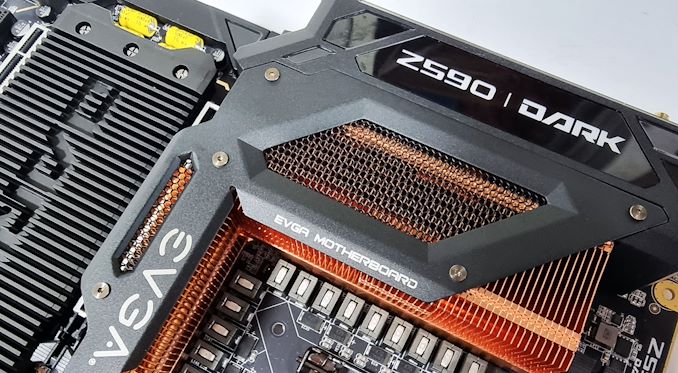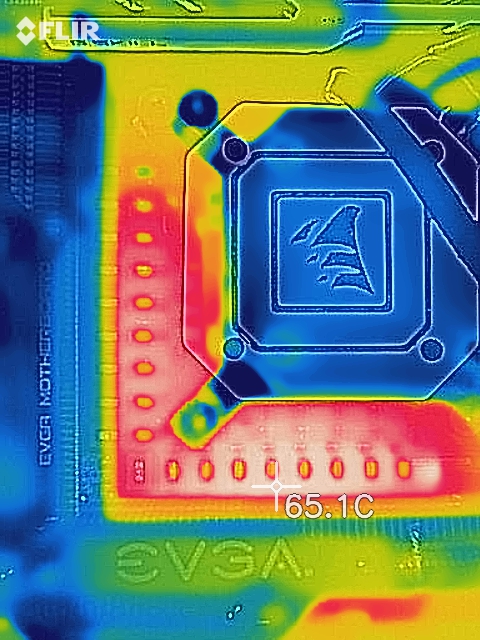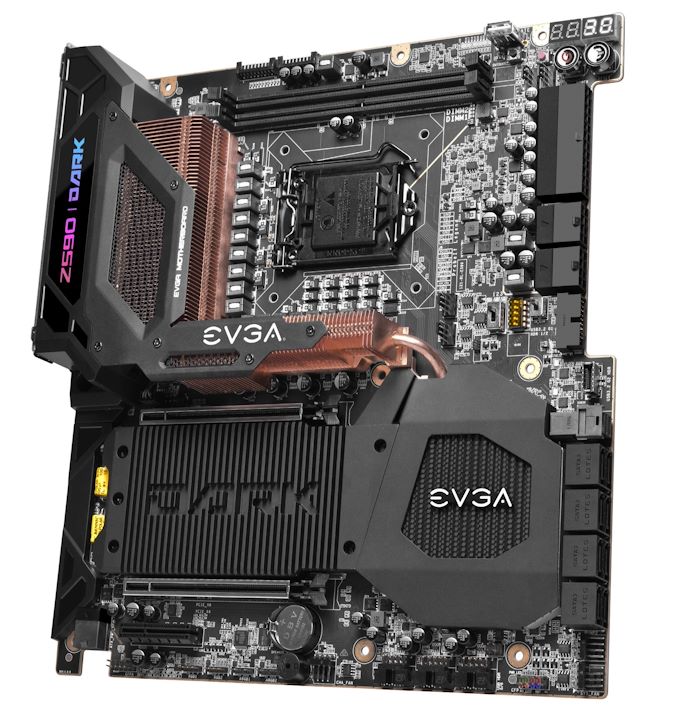The EVGA Z590 Dark Motherboard Review: For Extreme Enthusiasts
by Gavin Bonshor on October 15, 2021 9:00 AM EST
Getting the most out of Intel's Core i9-11900K primarily relies on two main factors: premium cooling for the chip itself, and a solid motherboard acting as the foundation. And while motherboard manufacturers such as EVGA can't do anything about the former, they have quite a bit of experience with the latter.
Today we're taking a look at EVGA's Z590 Dark motherboard, which is putting EVGA's experience to the test as one of a small handful of LGA1200 motherboards geared for extreme overclocking. A niche market within a niche market, few people really have the need (or the means) to overclock a processor within an inch of its life. But for those that do, EVGA has developed a well-earned reputation with its Dark series boards for pulling out all of the stops in helping overclockers get the most out of their chips. And even for the rest of us who will never see a Rocket Lake chip pass 6GHz, it's interesting to see just what it takes with regards to motherboard design and construction to get the job done.
EVGA Z590 Dark Overview
EVGA occupies an unusual spot within the wider motherboard market. The company has eschewed low-end and mid-range motherboards entirely, opting to focus on high-end boards. Case in point: of the handful motherboards they currently offer, the major of them are Dark boards aimed at extreme overclocking.
The end result is that while EVGA doesn't make (or sell) a lot of boards, what they do make stands out. And in the case of the Dark series (and thus the Z590 Dark) that starts with outright over-engineering motherboards in order to equip them with far more (or far higher grade) components than are actually needed. For a motherboard to operate within its parameters, such as Intel default settings on processors, they don't require things like ridiculously high phase counts to achieve this. But for extreme overclocking, it's another matter.
Some may say that overclocking isn't as popular as it once was, and to some degree that's true. Due to the advancements from both Intel and AMD on its methods and definitions of 'turbo' and 'boost,' it's not as fundamentally needed as it once was.
But don't tell the EVGA Z590 Dark that. Going so far as to support aggressive sub-ambient CPU cooling methods like liquid nitrogen (LN2) and dry ice (DICE), the EVGA Z590 Dark is a serious contender for those looking for maximum performance. An overclocker's toolkit is designed to make sub-zero overclocking more accessible, including dual Probelt voltage monitoring points and a dual two-digit LED debugger that can even read out current CPU VCore and temperatures.
It uses a transposed LGA1200 socket for better CPU pot mounting. Above the CPU socket is two horizontally mounted memory slots with support for DDR4-5333 out of the box and a maximum capacity of up to 64 GB, more than ample for anyone's desktop system. Other fanciful design traits include right-angled connectors, including the power connectors along the right-hand side, s |USB headers, and 4-pin fan headers.
With that said, not everything is aimed at overclocking, so the Z590 Dark includes a solid and fundamental feature set to boot. There's plenty of variety for storage with one PCIe 4.0 x4 M.2, one PCIe 3.0 x4 M.2, one PCIe 3.0 x4/SATA M.2, one rare PCIe 3.0 x4 U.2 slot, and eight SATA ports. Also present is a premium onboard audio solution and plenty of networking options with two 2.5 GbE controllers and an Intel Wi-Fi 6 CNVi. Other features include USB 3.2 G2x2 Type-C connectivity on the rear panel through native support on the Z590 chipset, while the Z590 Dark also has four USB 3.2 G2 Type-A ports.
Touching on the performance of the EVGA Z590 Dark in our testing, it showed that it's competitive with other Z590 boards we've tested. It's not as power-efficient as some other Z590 models, but we got good results in our POST time test, and it displayed incredible performance in our DPC latency testing. The performance in our compute and gaming benchmarks also shows the Dark is competitive with other models on test.

The EVGA Z590 Dark undergoing our VRM thermal testing
When it comes to overclocking, which the EVGA Z590 Dark is primarily designed for, we admittedly didn't see anything overly special compared to other Z590 boards – but then we "only" used a premium Corsair 360 mm AIO, rather than something more exotic. Still, the EVGA OC Robot utility built into the firmware was able to provide us with an impressive 5.4 GHz all-core stable overclock, but with a CPU VCore of 1.541 V and a whopping power draw of 497 W. Pragmatically, this overclock did run with a minus 3 offset on AVX workloads which meant it passed our POV-Ray benchmark. Still, we did see thermal throttling due to the insane amount of heat generated. Power delivery thermals were also respectable, but we would have liked to have seen better thermal performance than we got considering this board has an active cooling design.
Reflecting its high-end nature, the EVGA Z590 Dark carries a price tag of $599. And somewhat surprisingly, this isn't too outlandish for an enthusiast-grade overclocking motherboard in today's market, particularly when sizing up other high-end boards. Still, motherboards such as the MSI MEG Z590 Ace ($430) offer a much more comprehensive feature set with very competitive performance levels for users who aren't going to be applying dry ice to their CPUs. So where the Z590 Dark excels is going to be different from other high-end boards, and that's something that suits EVGA just fine.
Read on for our extended analysis.












27 Comments
View All Comments
gavbon - Saturday, October 16, 2021 - link
Value is all relative to what a user is willing to spend. For extreme overclocking, that's dependant on the qualityAlistair - Friday, October 15, 2021 - link
Quick! Buy it 2 weeks before it is obsolete! Hurry! ;)Silver5urfer - Friday, October 15, 2021 - link
Obsolete ? LGA1700 ADL is going to be a generation first product on DDR5 with Gear 4 and Gear 2, on top of new trash cores shoved in because of high power consumption. Plus a basic PCIe5.0 for GPU X16 only. Yeah more DMI and more lanes but questionable Intel Hardware Scheduler on top of the big little BS first adoption on top. Plus the added cost for all the new tech.If we follow the leaks ADL barely matches Zen 3 in SMT and perhaps in ST boost how it translates to real world ? Gotta see, RKL was also like that but came at huge power spike and not much in SMT. This new ADL has inferior cores going to magically beat in real workloads ? Nah.
Nope this platform is not Obsolete only issue is PCIe NVMe SSD slots aren't there and must use PCIe slot and RAID them. If used with 10th gen then PCIe3.0 will be a negative on the GPU lane when used with NVMe SSDs.
Alistair - Friday, October 15, 2021 - link
You can buy it using DDR4 and it is in no way inferior, if you don't want DDR5. The new big cores are just better than Rocket Lake big cores, so who cares about the small cores, those are just extra. With Intel you can even disable any cores you don't want. Why are you comparing to AMD when we are talking about Z590 being obsolete vs the latest Intel, AMD has nothing to do with my comment. A lot of funny responses in your comment.Silver5urfer - Friday, October 15, 2021 - link
It's not obsolete is the fact gauging by the performance it offers. The fact that AMD was mentioned is because on how RKL was compared to it and had ST advantage but nothing in SMT and huge power draw.Small cores no one cares ? Are you drunk lol. Intel is screaming from their chest that these 8x Atom trash are better than SMT cores AND the fact on how the Cinebench leaks showed it barely reaches to AMD's top SKU in the same tests. And you think disabling those small cores is going to net you the performance boost that Intel is claiming, what a pathetic joke. Those cores are needed if you disable you lose SMT Multicore advantage. Period. AND finally DDR4 is Gear 2 by default there was a latest leak saying Gear 1 is maxed out at 3600MHz probably similar or could be worse than RKL IMC.
You took the AMD and other aspects and discarded everything related to being a new platform on top of the extra costs, done with your kind of garbo useless replies.
amnesia0287 - Friday, October 15, 2021 - link
Assuming anyone will be able to actually find them in stock. I wasn’t under the impression intel had solved the silicon shortages.Wrs - Sunday, October 17, 2021 - link
Oh come on, Z590 is at higher risk of obsolescence than a typical chipset. Every CPU supported is 14nm. You could be stuck between the power hungry RKL and the soon to be two generation lag of Comet Lake. Both already have problems comparing to Ryzen.LGA1700 should offer you the ability to reuse ddr4. The number of technologies being added is what obsolescence is about, no? The only thing to save Z590 from obsolescence is if ADL is trash, and you simply don't know that, not from the public leaks.
Flying Aardvark - Sunday, October 17, 2021 - link
That makes no sense. RKL is the fastest gaming CPU where it counts, minimum frames per second / 99th percentile. https://www.tomshardware.com/reviews/best-cpus,398... Take a look for yourself. Who cares if it's 14nm? Larger process nodes have their advantages as well. Performance is what matters. If you're looking to save on energy, buy yourself a tablet. The only thing obsolete is whatever you're running in your rig today instead. Ryzen has plenty of problems, you're just not informed. Stay salty, poor boy.Wrs - Sunday, October 17, 2021 - link
Obsolescence is about what's around the corner, not what you have today. I just think buying any Z590 today is asking for buyer's remorse. Around the corner, we're expecting expanded cache Ryzens for AM4 - which may not be much except for gaming - and ADL on Z690. ADL consists of two new cores on a finer process (I consider it coequal with Zen 3's 7nm), translating to a higher overall core/thread count and cache, and ITD with all its potential game optimizations. Unless ADL has a poor showing or developers don't support ITD, won't ADL make Z590 suddenly feel lackluster? It could be a mild Pentium 4 moment.It's true that RKL holds pole position for most games right now. It's just that the edge over a 5800x is really small, the cost of that power budget is substantial, and many of us weigh other workloads too, including multitasking while gaming.
Silver5urfer - Monday, October 18, 2021 - link
As a platform probably yes because of only I/O - PCIe3.0 for CML and RKL gettin Gen 4 but at 8C max and insane ABT power spiking and heat. In terms of performance not yet. ADL is a brand new platform and with questionable core design it's already having a lot of news around DRM, Application optimizations and etc. Why should I pay for beta testing a product ? Esp when the DDR5 is so new and PCIe5.0 barely has any effect and the whole socket longevity along with Intel Thread Director drama and Win11 shenanigans ??Intel clearly lost their way. RKL was the first sign of that, IMC massively downgraded on that. With ADL DDR4 is not going to run at 4000MHz C15. It's not going to happen. The leaks show max of 3600MHz just like AMD, AM4 platform has a TON of issues, I was on the verge on pulling a trigger on Crosshair 8 Dark Hero but the USB drop out, WHEA issues, random PCIe issues, million AGESA updates. FCLK instability all these are there some of them only if you push the CPU but what's the point in buying a 16C or 12C processor and shoving it in an OC capable high VRM mobos likes of Aorus Master or Xtreme etc or even the X570 DARK and run it on all stock ?
All of these compound to one thing per my analysis, CML / RKL LGA1200 is a better mature platform to put money in for the next 5 years of it's life.